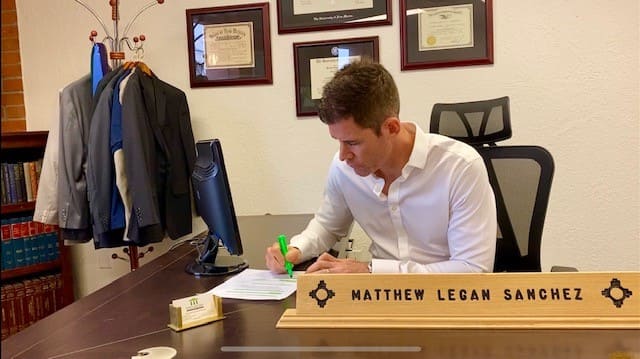
How APD Officers Investigate DWI in Albuquerque
Are you interested in how APD Officers investigate DWI in Albuquerque? Today, I will outline what a police officer is looking for after the initial traffic stop, and what to expect when an officer suspects that you are driving while intoxicated.
HOW APD OFFICERS INVESTIGATE DWI — INITIAL STOP
Regarding the initial stop – a police officer always needs a reason to stop your vehicle. In legal jargon he needs a “individualized, particularized suspicion” that is based on all of the information at their disposal that a law has been broken, or is being broken. In other words, the officer must demonstrate that they stopped your vehicle because you either broke a law, or are presently breaking a law – not that they had a “hunch” that you would break a law, or that you looked suspicious or shady. Typical reasons for the initial stop include: speeding, no turn signal, careless driving, expired tags, reckless driving, failure to maintain lane, etc. Nevertheless, the officer always needs a specific reason for stopping your vehicle – so never give an officer a reason to stop your vehicle. By obeying all traffic laws you are taking away the police officer’s power to stop your vehicle in the first place.
Keep in mind that from the moment you give the officer a reason to stop your vehicle, by breaking a traffic law, the officer is looking for additional evidence to place you under arrest for driving while intoxicated – anything you say, or do can and will be used against you, as the officer looks for evidence to place you under arrest. The officer isn’t trying to determine if you’d make a great pen-pal or friend, he’s trying to develop the requisite probable cause to place you under arrest.
APD OFFICERS OBSERVE SIGNS OF INTOXICATION
After the officer has initiated the stop they will watch how you react for any signs of intoxication. As you are stopping your vehicle the officer is looking for the following signs of intoxication: (1) slow responses, (2) failure to signal, (3) wrong signal, (4) unsafe lane change, (5) stopped in middle of the intersection, (6) stopped too close, or too far away from the curb, (7) stopped at an inappropriate angle, (8) hit the curb or another object during the stop, rolling stop, etc. . .
As the officer approaches your vehicle – and meets you face-to-face – they are looking for any unusual behavior, or signs of intoxication. The officer almost always lists the following observations in their report: “Upon contact with the driver I observed signs of intoxication including blood shot watery eyes, slurred speech, and scent of alcohol emanating from the vehicle.” You can expect a variation of that statement to appear in any criminal complaint for DWI. The officer is also looking for other clues to include in their report such as: (1) unusual behavior, (2) odd gestures, speech patterns, and any other aggressive or unusual behavior, etc. . .
HOW APD OFFICERS INVESTIGATE DWI — ADMISSIONS
The officer will then ask if you’ve had anything to drink. Any admissions of drinking – no matter how much – will be used as probable cause for your arrest. I repeat – any admissions of drinking will be used as evidence for your arrest. At this point the officer is also looking for any signs of intoxication including: (1) soiled clothing, (2) fumbling fingers, (3) alcohol containers, (4) unusual actions, etc. . .
The officer will then ask for your license and registration, and is looking for the following behavior: (1) did you fumble for the information, (2) did you produce the correct information, (3) did you fail to see the license or registration during your search, (4) did you provide the correct answers to the officer’s questions, (5) did you fumble or drop the wallet, purse, license or registration, and (6) were you able to retrieve the documents with your fingertips, etc. . .
Assuming that the officer has reasonable grounds to believe that you were driving while intoxicated – the officer will then ask you to exit the vehicle. While you are exiting the vehicle the officer is looking for: (1) angry or unusual reactions, (2) inability to follow directions, (3) difficulty with motor vehicle controls, (4) inability to open the door, (5) leaning on the door for support, (6) leaving the vehicle in gear, etc. . .
WHAT ARE FIELD SOBRIETY TESTS IN ALBUQUERQUE NEW MEXICO?
At this point the officer will begin the standardized field sobriety tests – a series of divided attention tests that test your coordination and ability to follow directions. These “tests” are not pass fail, and they are not designed to measure your level of impairment. They are merely tools that assist the officer to develop the probable cause for your arrest.
Horizontal Gaze Nystagmus (HGN) Test in Albuquerque
The first test given is the Horizontal Eye Gaze Nystagmus. With this test the officer holds his finger, or another object, 12 to 15 inches from your nose, slightly above eye level. The officer will move his finger from the center of your nose to around the area of your shoulder, hold the position for a period of either 2 or 4 seconds, and then return to the center – beginning with the left eye. The officer will repeat the same process this time extending his finger to the area of about an outstretched arm – holding each position for either 2 or 4 seconds. During this process the officer is checking the movement of your eyes for either “smooth movement” or “jerky movements.” The officer is looking for “nystagmus,” which is an involuntary jerking, or a bouncy movement of the eye that is caused by intoxication. Because this is a scientific test, New Mexico law holds that a typical police officer does not have sufficient scientific knowledge to use this test to prove your level of intoxication at trial. Nevertheless, it can be employed as evidence to develop the probable cause leading to your arrest.
DWI INVESTIGATIONS AND WALK AND TURN TEST
The next test is the walk and turn. This test has a number of instructions that you are required to follow. The officer will watch to see how you respond to the following instructions:
First – you will be told to place your feet on a line in a heel-to-toe manner – with your right foot in front of your left foot – with both arms at your sides. You are instructed to hold this cumbersome position while the officer provides a demonstration of the test. Note that the officer will document any unusual movements while you are standing in this heel-to-toe stance.
Second – you will be told not to begin the test until instructed to do so, and asked if you understand.
Third – you will be told to take nine heel-to-toe steps, and the officer will demonstrate.
Fourth – the officer will explain the turning process, which involves turning with “short choppy steps.”
Fifth – you are told to return with nine heel-to-toe steps.
Sixth – you are told to count the steps out loud.
Seventh – you are told to look at your feet while counting.
Eight – you are told not to raise your arms from your side.
Nine – you are told not to stop once you begin the test.
Tenth – you are asked if you understand the instructions given.
HOW APD OFFICERS INVESTIGATE DWI — OFFICER OBSERVATIONS
While you are performing the test the officer will observe and document the following:
1. Were you able to balance during the instruction – i.e. in the heel-to-toe stance?
2. Did you start too soon?
3. Did you miss heel-to-toe by ½ inch or more – and if so on which steps?
4. Did you step off the line?
5. Did you stop during the test?
6. Did you take the correct number of steps?
7. Did you turn correctly?
8. Did you fail to follow any other instructions, or did the officer observe any problems with balancing, stumbling, falling, or inability to complete the test?
DWI Investigations and One Leg Stand
The next standardized field sobriety test is the one leg stand. This test is less complicated than the walk-and-turn. You will be instructed to:
1. Stand straight, place feet together, while holding both arms at your sides.
2. Told not to begin until instructed to do so – and asked if you understand.
3. Told to raise one leg – either leg – roughly 6 inches off the ground, and to keep your foot pointed out.
4. Told to keep both legs straight and to look at your raised foot.
5. Told to count as follows – one thousand one, one thousand two, one thousand three, etc., until you are told to stop.
While you are performing this test the officer is looking for the following clues:
1. Did you sway while balancing?
2. Did you put your foot down while balancing?
3. Did you raise your arms while balancing?
4. Did you hop, sway, fall over, etc., while balancing?
5. Did you fail to follow any of the instructions that were given.
HOW APD OFFICERS INVESTIGATE DWI — ADDITIONAL TESTS
This is typically where the field sobriety tests end. However, officers can give additional tests such as the finger dexterity test, the alphabet recital, finger-to-nose test, or a number count down – if they feel that they lack the probable cause necessary to place you under arrest for driving while intoxicated.
Based on all of the information above – your driving, your stop, the initial contact, your exit sequence, and your performance on the Field Sobriety Tests, or your refusal to perform the tests – the officer will determine if there is probable cause for your arrest. Probable cause is established if a reasonable and objective person would believe that you were driving while intoxicated, based on all of the information that the officer witnessed.
PROBABLE CAUSE AND THE IMPLIED CONSENT ACT IN ALBUQUERQUE
If probable cause is found the officer will place you under arrest, and will then read you the Implied Consent Act – which essentially is a New Mexico Act that states that driving is a privilege and not a right, and by driving in the State of New Mexico you have implicitly consented to have your blood or alcohol tested for the presence of drugs or alcohol.
At this point you have two options: (1) you can refuse to submit to the test, or (2) you can take the test.
If you refuse the chemical test, your offense will automatically be elevated to an aggravated DWI – which will mean a mandatory 48 hours in jail if you are convicted at trial, and having an interlock installed on your vehicle for one year, relative to six months – assuming that it is your first offense.
DWI AND BLOOD ALCOHOL TESTS IN ALBUQUERQUE, NEW MEXICO
By submitting to a chemical test, if you blow above a .08 you are per se guilty of drinking and driving. What this means is that assuming that there was a valid reason for the stop, probable cause for the arrest, and all of the requirements for a valid breath test are present – then you are per se guilty of drinking and driving – i.e. you are statutorily guilty of drinking and driving. For example, speeding is another example of a per se violation. If the officer can show that you were speeding, it doesn’t matter why you were speeding – going with the flow of traffic, broken odometer, etc. – you will be found guilty of speeding by virtue of the fact that you were over the legal limit. The same is true with driving under the influence of alcohol – assuming that the elements above are established.
By refusing the chemical test you no longer face the per se standard described above, by blowing at or above a .08. Nevertheless, you will now face the amorphous “impaired to the slightest degree standard.” Under the impaired to slightest degree standard, even though you refuse chemical testing, the state can convict you for driving while intoxicated if they can show that because of the effects of either drugs or alcohol “. . . to the slightest degree, either mentally or physically, or both, [you were unable] to exercise the clear judgment and steady hand necessary to handle a vehicle with safety. . . .” More importantly, as discussed above, if you decide to bring the case to trial you will face a minimum of 48 hours in jail based on your refusal to submit to the chemical testing. Moreover, your refusal can be used to create an inference of consciousness of guilt, to establish the probable cause for arrest.
As you can see, the typical DWI case is layered with nuances and legal issues that are ripe for argument and discussion. The analysis above describes what the typical officer is looking for during their DWI investigation. The information above certainly is not an exhaustive review of the laws and procedures surrounding your individual case. I can provide you with an in-depth legal analysis for any specific issue that you have encountered based on a review of the facts of your case.
(505) SANCHEZ HELPS YOU UNDERSTAND HOW APD OFFICERS INVESTIGATE DWI IN ALBUQUERQUE NEW MEXICO
Have you been arrested for DWI in Bernalillo County? Matthew Legan Sanchez is an experienced DWI attorney in Bernalillo Metropolitan Court that handles Albuquerque DWI arrests. Sanchez can be reached by calling (505) SANCHEZ.

How APD Officers Investigate DWI






